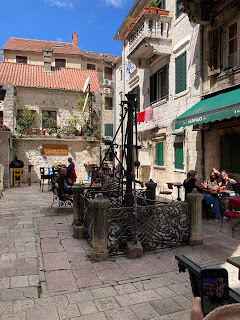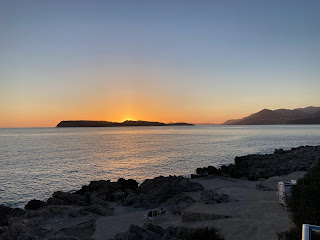We learned first hand today the meaning of the word, "balkanization." We traveled by bus from Dubrovnik, Croatia and crossed into the country of Montenegro (literally, the land of black mountains). It was about an hour drive, plus time spent at border crossings necessary to leave one country and enter another. Along the way, Croatia became so narrow that we could see Boznia-Herzegovina from the highway. These are very tiny countries!
 |
| Looking down on Dubrovnik Bay from the bus. |
The bus drove us to the border crossing, where we had to get off the bus one at a time and get our passports stamped that we were leaving the EU. After driving about 200 meters through a "no man's land," we had to stop again to gain entry to Montenegro. They were less strict, accepting from our tour leader a prepared list of our names and passport numbers.
The bus continued to the village of Perast, on the eastern shore of the Bay of Kotor. There we got onto a motorboat that could have easily taken a group twice the size of ours. The boat took us around two islands just off shore, then headed south toward Kotor, at the end of the bay.
The Bay of Kotor is quite narrow, with steep mountainsides all around. It could pass for a fjord, but our tour leader (who has a masters in geology) pointed out, a fjord is formed at the mouth of a glacier. There is no glacier here, just the uplift of two colliding tectonic plates.
On this beautiful day, the bay was gorgeous! The entire area is a UNESCO World Heritage Site, so construction of tourist hotels and other tourist infrastructure along the shore is heavily restricted. Even the huge cruise ships that navigate through the narrows to visit here are limited in number and must pay a rather substantial fee for each visit.
The town of Kotor is another Medieval walled city, somewhat like Dubrovnik in architectural style. The wall is still intact, but only a small portion of it can be walked. The town is tightly sandwiched between the mountain and the bay, so the inland side of the wall is a steep climb. A 1,000 year old fortress guards the top of the wall, and one must climb more than 1,300 steps to get to it (we passed on that opportunity).
 |
| The Roman Catholic cathedral is one of the oldest in Europe |
Kotor was under Venetian control much longer than was Dubrovnik, and the Italian influence is evident in the language and the names of places in the town.
A local guide took us on an orientation walk. The winding streets are very short, and none have names. But the streets connect a great many plazas or piatzas, and all houses are addressed by plaza name, rather than street name.
 |
| The town water pump in the "Gossip" plaza |
The piatzas are named for what was sold or done in them in previous centuries: The arsenal plaza was near the Sea Gate, because weapons were stored and practiced there in case the city had to be defended from a surprise attack by pirates. The flour plaza was surrounded by bakeries. The "gossip" plaza contained the town well, where everyone came to get water and to get the news of the day.
 |
| Very old and very tiny Orthodox church |
One plaza was dominated by the Roman Catholic cathedral. Another featured two Orthodox churches. Although Montenegro is dominated by Orthodox Christians, there are also sizable populations of Catholics and Muslims.
The town is definitely built on tourism, and souvenir shops and restaurants are the predominant businesses. After the town tour, our OAT tour leader took us outside the walls where we met a farmer who comes regularly to town to sell his homemade meats, cheeses, breads, and wines. We were treated to generous samples of each.
 |
| Churches as viewed from the walls |
Then we went with two other members of the group (the same two with whom we had walked the walls of Dubrovnik yesterday -- most of the rest of the group is not much for walking) and walked the section of Kotor's walls that are open to the public. The view was not nearly as spectacular as the walls of Dubrovnik, but it was a good walk, nevertheless.
The four of us then went to lunch at one of the many restaurants, sharing plates of the two local specialties: Mussels steamed in butter and garlic, and black risotto. The risotto gets its color by being cooked in squid ink. The mussels were fresh from the bay and very good. The risotto doesn't taste much different from the white risotto we enjoyed at yesterday's lunch. Only the color is different.
 |
| The Kotor music academy |
Following the meal, we split from the other two group members, who were intent on tasting the local cakes at one of the bakeries. We visited a few of the churches, and looked in a few of the shops, until it was time to meet the group.
 |
| Vehicles on the ferry |
The trip home was nearly a reversal of the trip there, except that the bus met us in Kotor and then drove onto a ferry for a much shorter crossing of the Bay. We got back to the hotel around 5:30 p.m.
After resting and snacking in our hotel room, we took a walk along the promenade that goes in front of the hotel along our own bay. We had walked it in the direction toward the bus stop to town, and knew it didn't go terribly far in that direction. It didn't appear to go much farther in the opposite direction, either.
We were wrong about that. The promenade went on and on, probably for nearly a mile. At the far end, we paused to watch the sun setting over the Adriatic before reversing course and heading back. It was a very pleasant walk on a very pleasant spring evening.








No comments:
Post a Comment